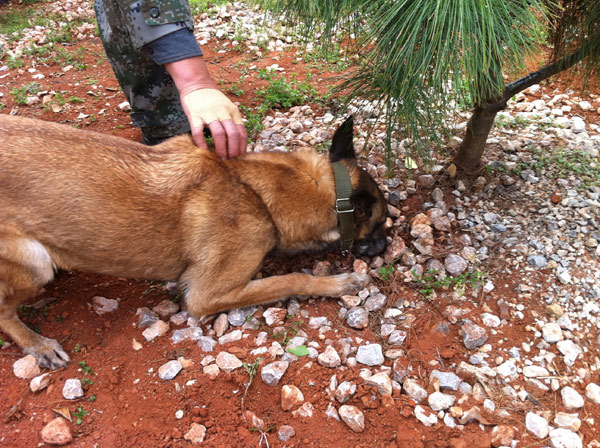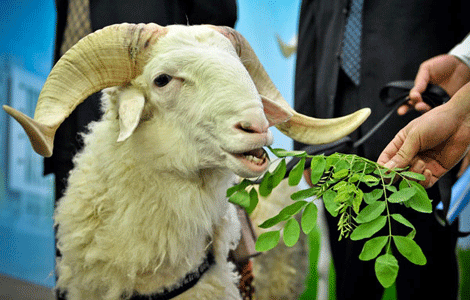
 |
|
A dog is trained to find the truffles under the host pine saplings. Guo Anfei / China Daily |
"Black truffles prefer more alkaline soil. In China, there are vast karst landform and limestone areas suitable for truffle plantation. When there is acid rain, and with industrial development, their growth is adversely affected," says researcher Liu.
Liu says China has discovered 29 species of truffles so far, while there are more than 100 known varieties in the world that can be roughly divided into high, middle and low grades.
The best quality truffles are the French black truffle and Italian white truffle. However, Chinese black truffle and summer truffle are related to the French black truffle and European summer truffle respectively. Liu believes there may be a truffle in China that is similar to the Italian white truffle.
Cultivated truffles taste no different from those that grow in the wild, Liu says, and they can be harvested about 40 to 50 years after planting.
After that, if properly protected and with careful management, they can still produce an annual crop every winter.
Truffles have more than 100 aromatic elements, and are rare, delicious and nutritious - which is why they are so expensive.
"Even though truffles can now be cultivated, their prices will not come down significantly. As people can afford more luxury, the demand will grow rapidly. What was available only to the elite is now available to many more," Liu says.
Under the research program by the Institute of Botany, every hectare of cultivated truffles can yield about 300 to 450 kg, and at the current prices of 1,500 to 2,000 yuan per kilogram, each hectare of land will bring in about 450,000 to 900,000 yuan.
Truffle planting can also be a lucrative source of income for local farmers in the regions suitable for truffle growth.
While Italy and France are already famous for their truffles, Yunnan in China has only just started supplying restaurants with these "black diamonds".
Truffles have been known in China a long time, and locals in the truffle producing regions called it the "pig-snout fungus" because sows forage for them in the ground.
Besides Yunnan and Sichuan, the Kunming Institute of Botany has also started truffle mycorrhizal plantation tests in Xinjiang, Inner Mongolia, Ningxia, Jiangxi, Zhejiang and Beijing, using different host trees and truffle strains.
"Truffles can be cultivated on barren limestone mountain slopes and it can help the re-forestation process, preventing soil erosion and water loss," Liu says.
Black truffles are exacting about the type of trees, climate and soil they grow in. Liu says the truffles prefer Yunnan pine, Huashan pine, Chinese chestnut, hazel and oak.
They also prefer an altitude of 1,000 to 2,800 meters above sea level where the soil is rich in limestone and calcium, and slightly alkaline - most of these conditions being found in Southwest China.
"The most difficult parts of our research and experiment was the truffle ectomycorrhizal synthesizing, such as truffle inoculation, mycorrhizae detection, transplanting and careful management. These steps may sound easy, but they were very challenging in reality," Liu says.
Choosing the right trees to grow the truffles was the first difficulty.
Liu's team needed to find the right base culture for the infection of the fungus. After planting, the team had to ensure the inoculation had the proper pH value, temperature, the right amount of water and sunlight.
Pollution must be monitored or it can kill the fragile microcosms during the synthesizing process. And after the culture takes root, proper maintenance must be observed, including pest prevention, weed control, watering, and pruning of the trees to allow the truffles the optimum conditions to grow.
Liu says the Kunming Institute of Botany is the first to cultivate black truffles in China. The truffles are expected to be commercially available in about four years' time.
Ye Jun contributed to the story.







